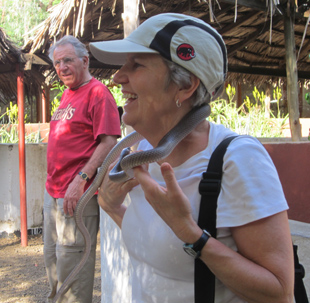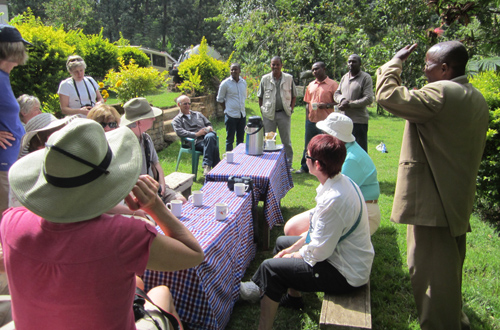
A vacation, time-off, a holiday – they all evoke images of a breezy, sunny beach, lazing on a hammock swinging softly near a smartly uniformed attendant serving margaritas. That’s not a safari. While there are outfitters who promise exclusivity, rests in the woods with little of a schedule, that’s not what the vast majority of people who come here expect.
They expect above all, wild animals, and there’s no doubt the vast majority of travelers here are animals lovers. And they don’t expect a lazy hammock swinging softly in the breeze. They expect to be roused earlier than normal, herded on schedules into vehicles, and long, long drives over bumpy, dusty roads.
No pain, no gain. In the end the view of the pride of lions with the furry youngsters monkeying around validates the effort. But the effort is considerable, and travelers know that.
So I’ve tried throughout my career to maximize my travelers’ fortitude. And today I think represents a great success. We didn’t start until 9 a.m. Our bumpy ride was but a few kilometers. But the view we got at the end of the day I consider as important as a pride of lion playing.
We spent the day with the “middle class” if you will, of modern Africa.
More than 2/3 of all Maasai in the three countries in which they live are hard working, modern people who live in tight-knit communities that probably remind most of my older visitors of America’s deep south as World War II was ending.
Houses are modest but functional with plumbing and electricity, many in some disrepair for wont of better and expensive maintenance, roads that are horrendous, but communities that take pride in their history, their businesses and above all, their schools.
They are teachers, store owners, taxi drivers, business people and of course, tourism service providers. The Maasai community that we visited on the slopes of Mt. Meru has not lived a nomadic existence herding cows and goats for nearly 200 years.
After being briefed by the village chairman whose wife served us coffee and tea in her garden, we were escorted by a young man studying economics in a local college and who spoke excellent English. He explained that there were around 4500 people in the village. “Village” is a political term in modern Tanzania, similar to a town in America.

We saw people working in their farms, women carrying large bundles of wood on their heads, successful men proudly stacking the cement blocks of their better houses and were also escorted to the edge of the village where “traditional houses” existed in a sort of village remembrance of their heritage.
And much of the tour was spent at the primary school. The headmaster brought us into an older class and gave them the opportunity of asking us questions. Among those asked were, “Are you married?”, “How did you get here?”, “Where are you from?”, and “What do you do?”
After each of us explained what we did, the Headmaster asked how many of the classroom of about 50 students would also like to become a such-and-such, an invariably most of the hands were raised enthusiastically.
Until Phil Lopes said he was a politician. There was a pause from the Headmaster until Phil prompted him to ask, “Why don’t you ask how many want to be politicians?”
Enthusiastic laughter and hands-up response.
From Ngeresi village we went into town and had lunch at a local diner, the kind most of the working, modern Maasai in Arusha use for lunch during the work week. The choice of fish, beef, chicken or beans and rice; served with rice, ugali or chapati was unanimously considered a good, solid meal. The cost? $2.10 each.
We ended the day at a couple other Arusha area attractions including the Meserani Snake Park, where the Maasai Charles guided us in front of the several dozen snake cages describing how quickly death came from each bite… Well, a lot more actually, like the type of toxic, how bites are treated and why people get bitten.
The Maasai we met and who befriended us today actually call themselves “wa-Meru” rather than Maasai, to distinguish themselves from the traditional (archaic: “primitive”) ways of their ancestors. But their language and their not so distant ancestry is the same, and I have hired Maasai driver/guides here — some of the best I’ve ever had — who herded goats on the distant Serengeti as a young boy calling themselves “Maasai,” and then developed a careers in Arusha town calling themselves “wa-Meru.”
The Vice President of Kenya was a Maasai. The CEO of Kenya Airways is a Maasai. Prominent Maasai fill Africa’s boardrooms. But it isn’t just the most modern and the most primitive. The men driving my clients around Tanzania, explaining the intricacies of acacia dependence on giraffe or the complexity of Tanzania’s new constitution, or discussing the problems of a their children during the teen years of texting – they, too, are Maasai.
It was a long, productive, nonanimal day and I’m now doubly encouraged to give these wonderful clients the finest game viewing in the world. I hope they felt the day worthwhile, a day that might have changed their notion about what a Maasai is.
